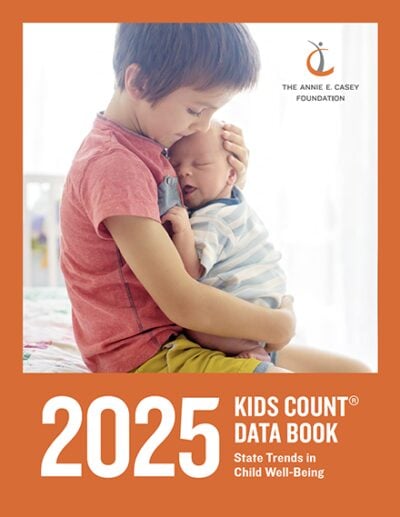
KIDS COUNT indicators capture what children and youth need most across four domains:
Each domain includes four indicators for a total of 16.
Because state policies play a critical role in shaping children's lives, a child's future success often depends on where they grow up.
This year’s Data Book tells a mixed story — steady progress in some areas, setbacks in others and opportunities to do better for kids and families.
Since 2019, seven of the 16 key indicators have improved, six have worsened and three have stayed the same. Bright spots include:
Some of these trends reflect years of progress. Others highlight the resilience of children and families after the COVID-19 pandemic and the success of strong policies that provided support during that time.
Among all four domains, Education saw the biggest decline — 3 out of 4 education indicators worsened since 2019:
Still, there's encouraging news: High school graduation rates continued to rise, a sign of students’ perseverance and the support of families, schools and communities.
In 2023, only 5% of children were without health insurance, down from 6% in 2019. This is an encouraging milestone made possible through coordinated, effective policy.
The Family and Community domain also shows promise:
These trends show that meaningful progress is possible, especially when investments are targeted and sustained.
However, serious challenges remain as 16% of children still live in poverty, and nearly 1 in 3 children live in households struggling with high housing costs.
Where a child lives continues to matter deeply, with stark geographic disparities shaped by local and state policies, economic conditions, community investment and infrastructure.
This year's Data Book highlights these patterns clearly:
These gaps aren’t just between states, however: They show up between neighborhoods and ZIP codes.
Looking closer, each state shows a mix of progress and ongoing needs. Some states made strong gains — like higher graduation rates or less concentrated poverty — while still facing deep challenges. Others that rank highly overall still struggle with persistent child poverty or housing burdens. Strong state-level numbers can sometimes mask the struggles of individual children or communities.
We know what helps kids thrive: stable homes, strong schools, nutritious food, supportive relationships and real opportunities to learn and grow. These aren’t luxuries, they’re basic needs, shared by all children in all communities, and meeting them is a shared responsibility. We need action at every level — backed by data, shaped by what families say they need and committed to ensuring that all young people have the chance to succeed.
When we get it right, we’re not just helping children — we’re strengthening the workforce, reducing long-term costs and building a better future for everyone.
View the national data profile or download your state's data profile as a PDF below:
View the 2025 national data profile in Spanish or download your state's data profile as a PDF below:
The Foundation calculates a composite index of overall child well-being for each state by combining data across four domains: (1) Economic Well-Being, (2) Education, (3) Health and (4) Family and Community. These scores are then translated into state rankings. Explore overall child well-being in the interactive KIDS COUNT Data Book.
To help children grow into prepared, productive adults, parents need jobs with family-sustaining pay, affordable housing and the ability to invest in their children’s future. Explore economic well-being in the interactive KIDS COUNT Data Book.
The early years of a child’s life lay the foundation for lifelong success. Establishing the conditions that promote educational achievement for children is critical. Explore educational well-being in the interactive KIDS COUNT Data Book.
Children’s good health is fundamental to their overall development, and ensuring kids are born healthy is the first step toward improving their life chances. Poor health in childhood affects other critical aspects of children’s lives, such as school readiness and attendance, and can have lasting consequences on their future health and well-being. Explore health indicators in the interactive KIDS COUNT Data Book.
Children who live in nurturing families and supportive communities have stronger personal connections and higher academic achievement. Explore familial and community well-being in the interactive KIDS COUNT Data Book.
We hope you'll find value in this report. We’d love to get a little information from you, which we'll use to notify you about relevant new resources.